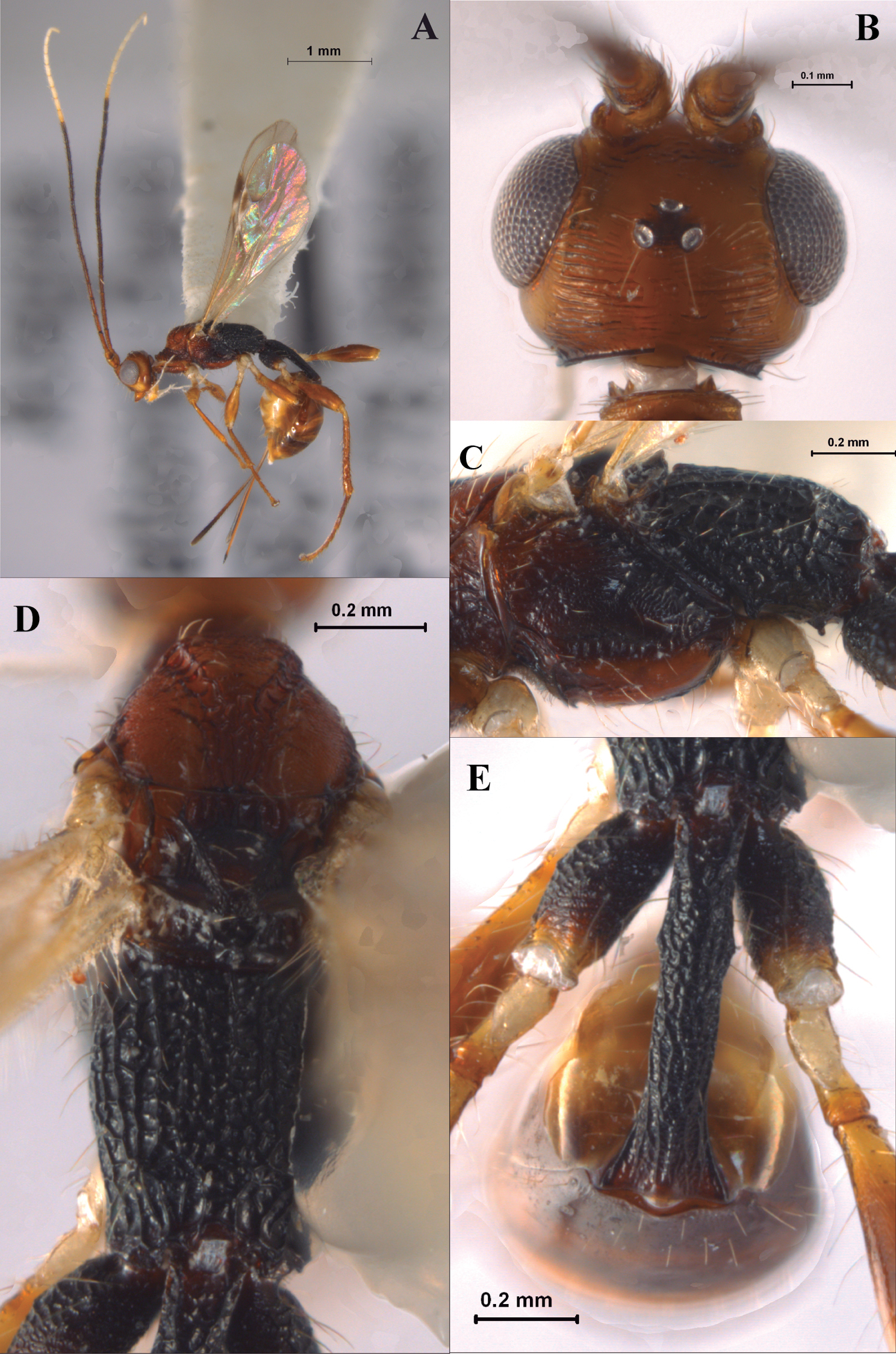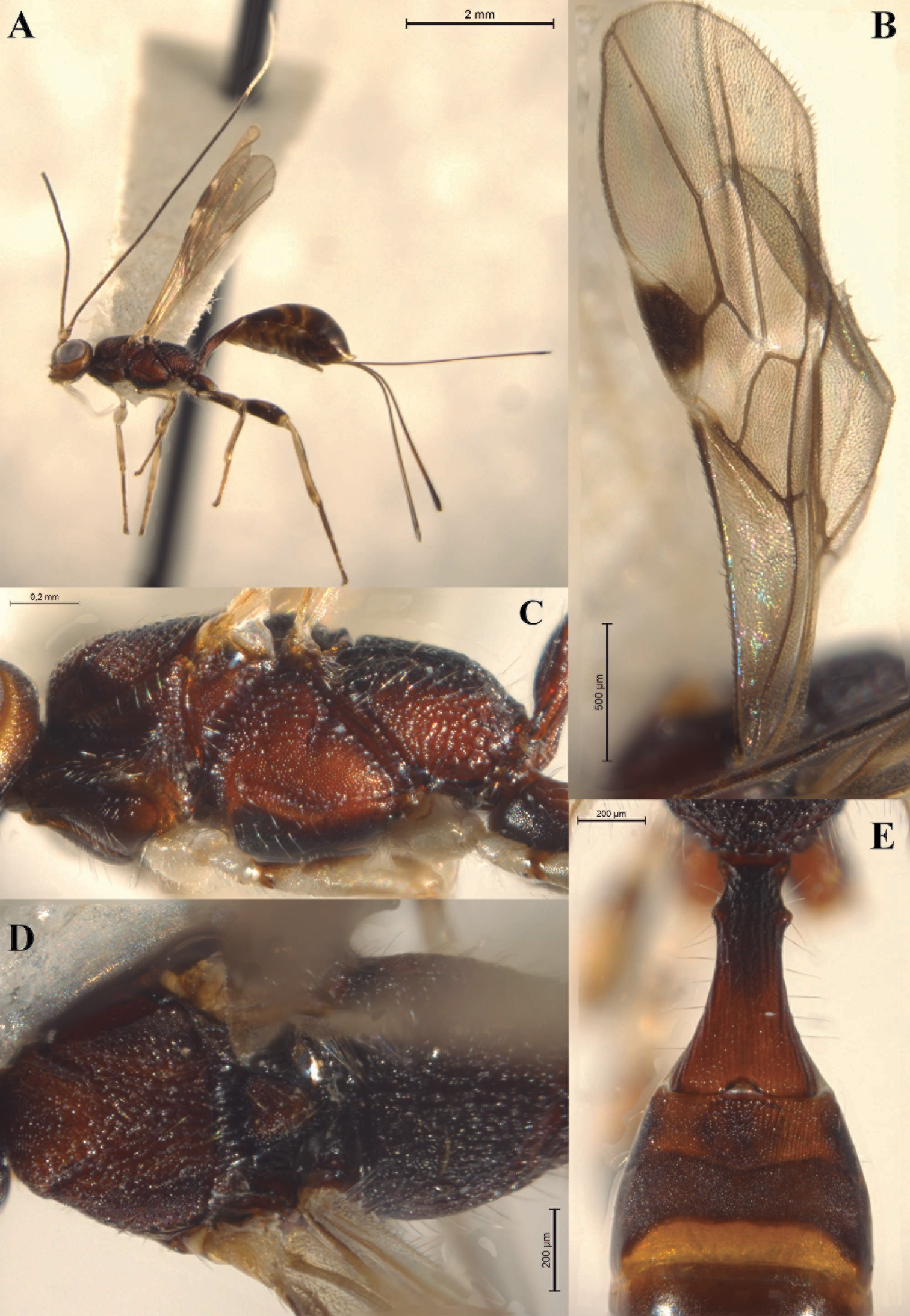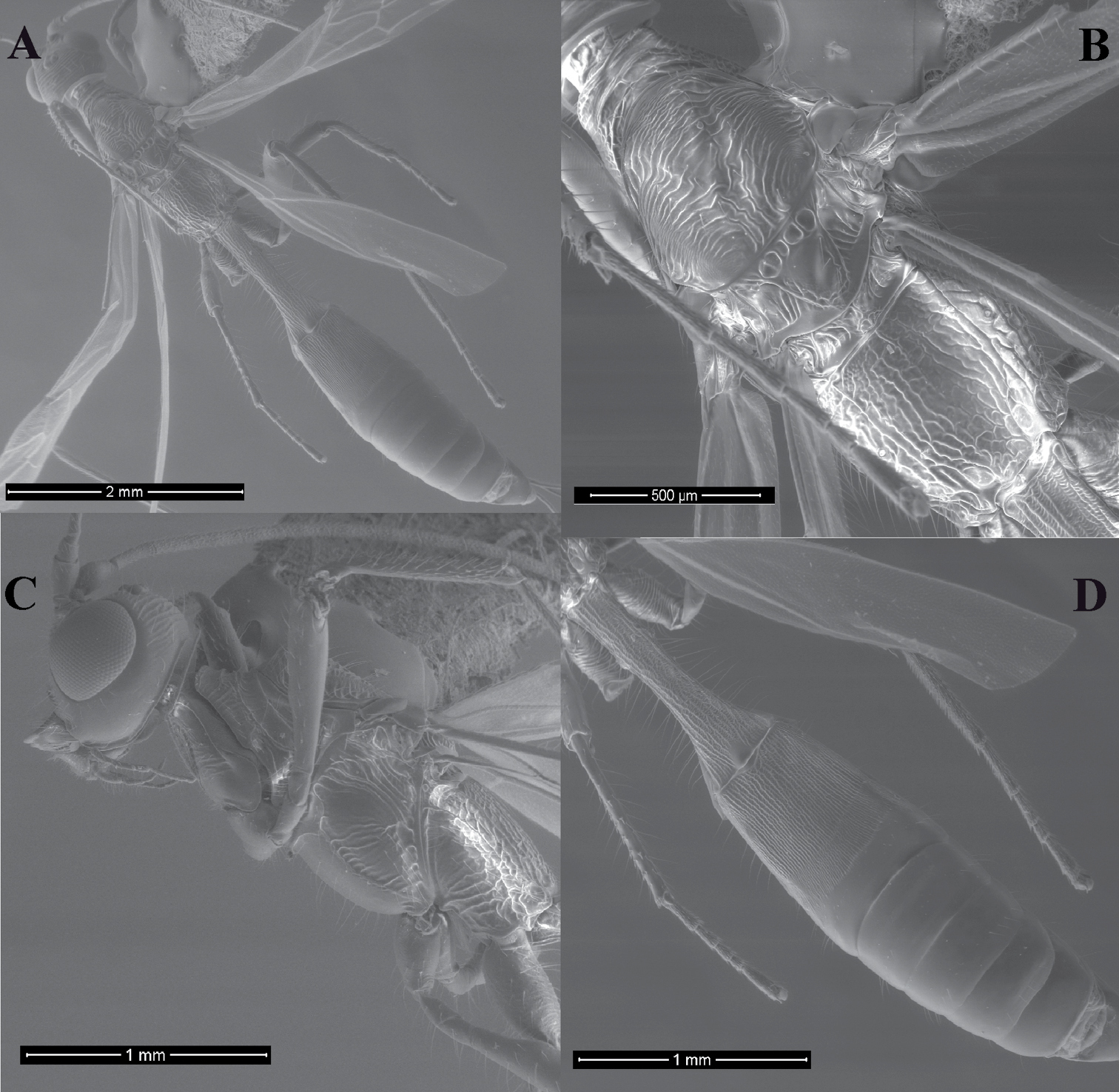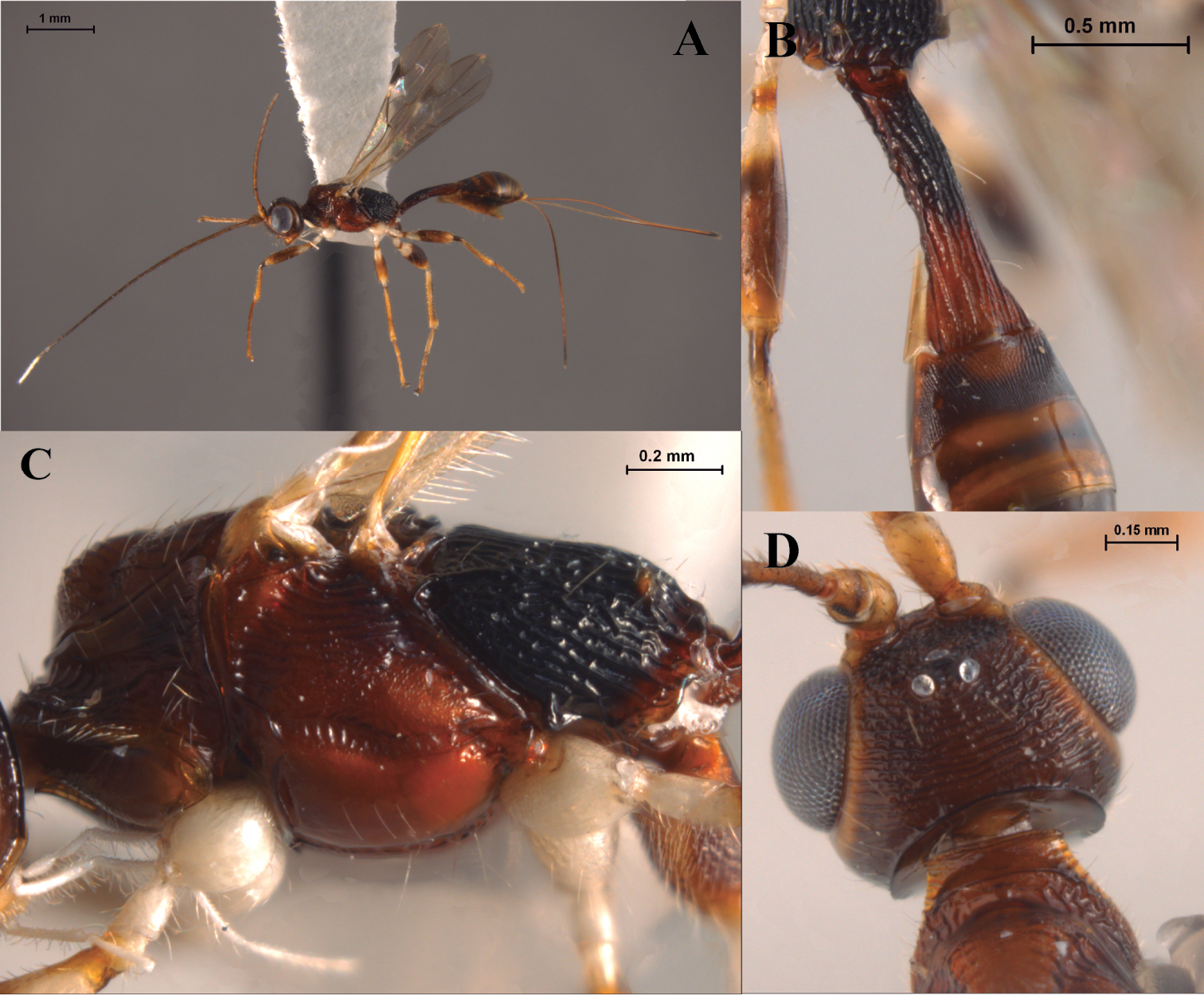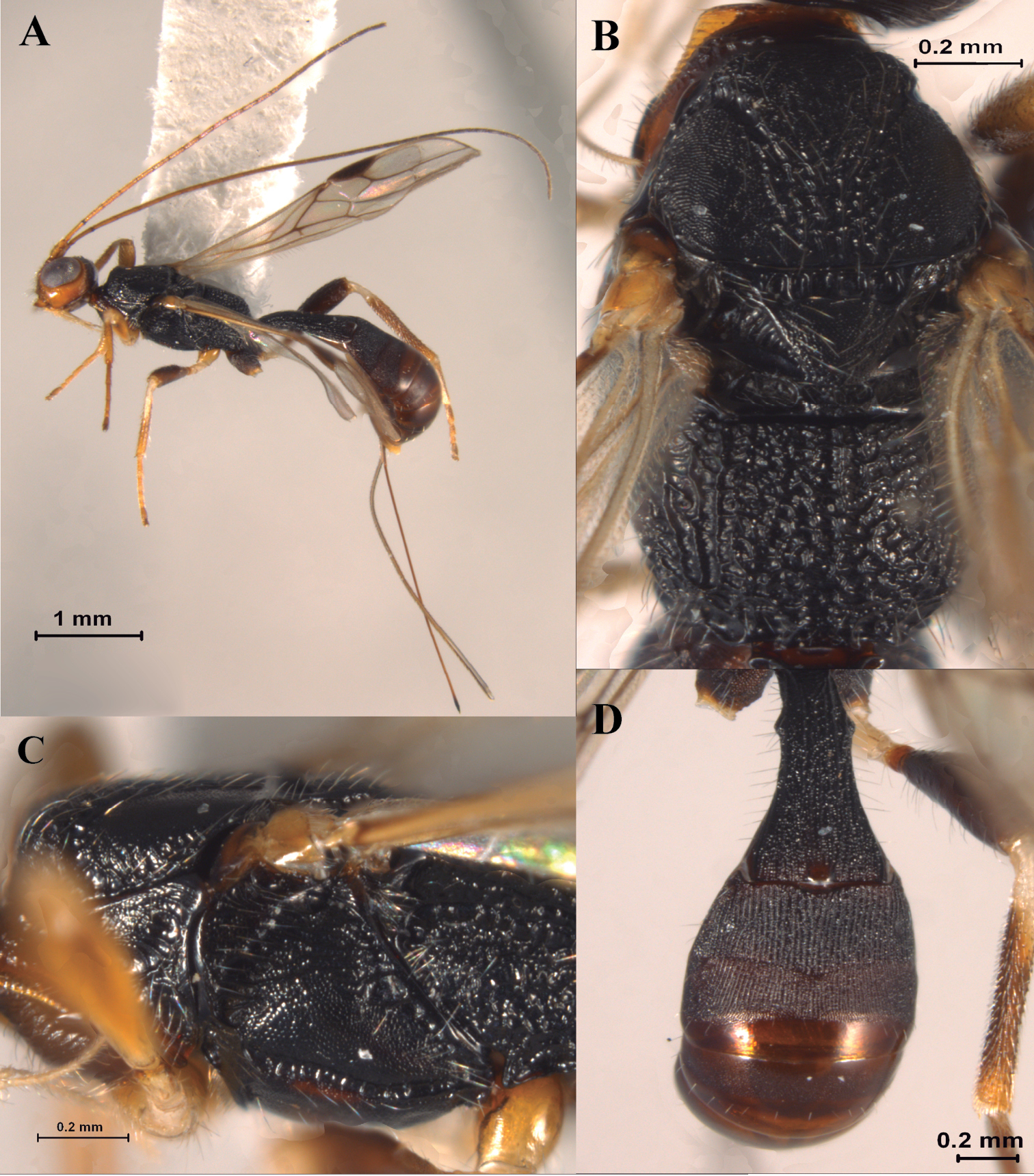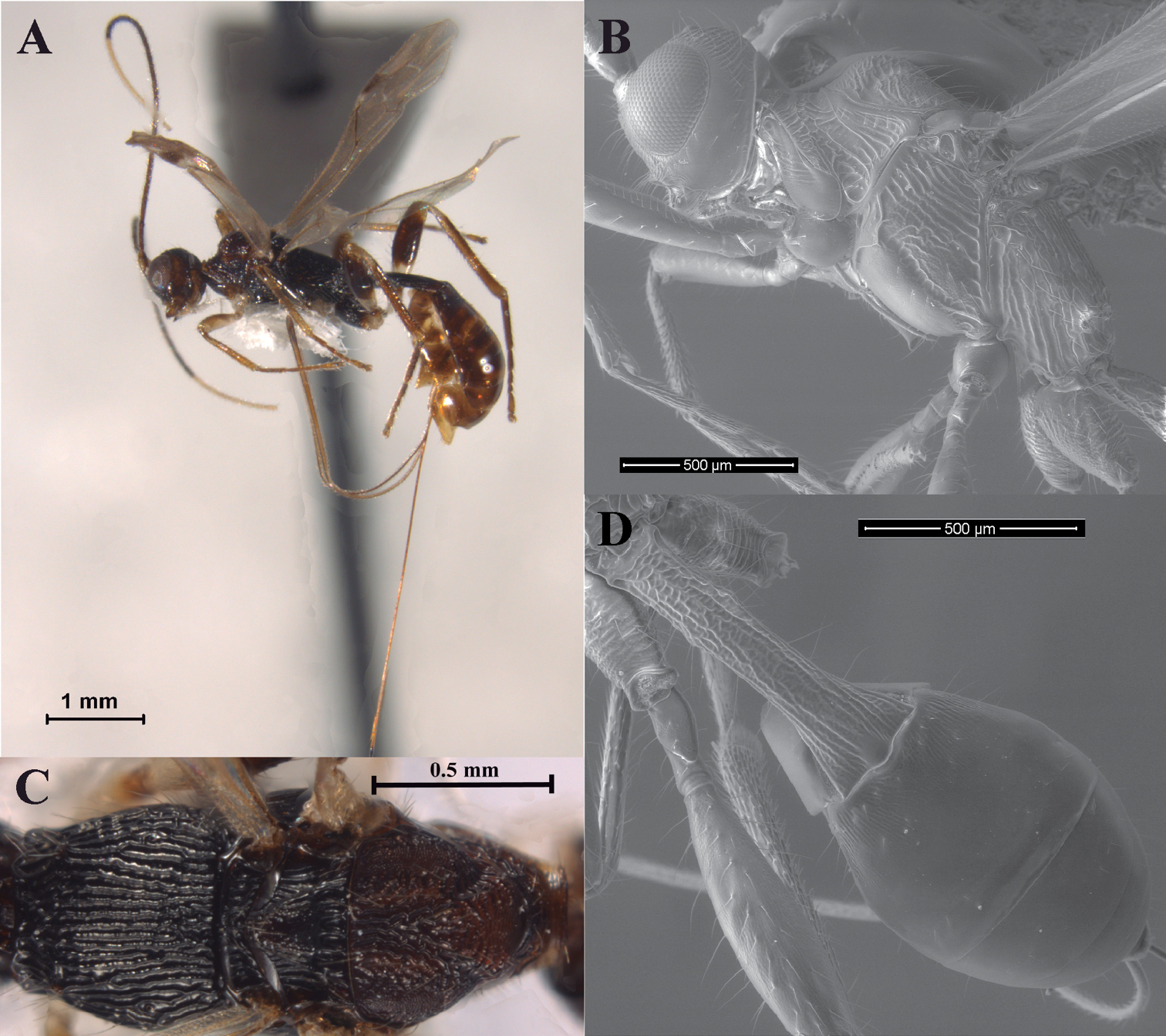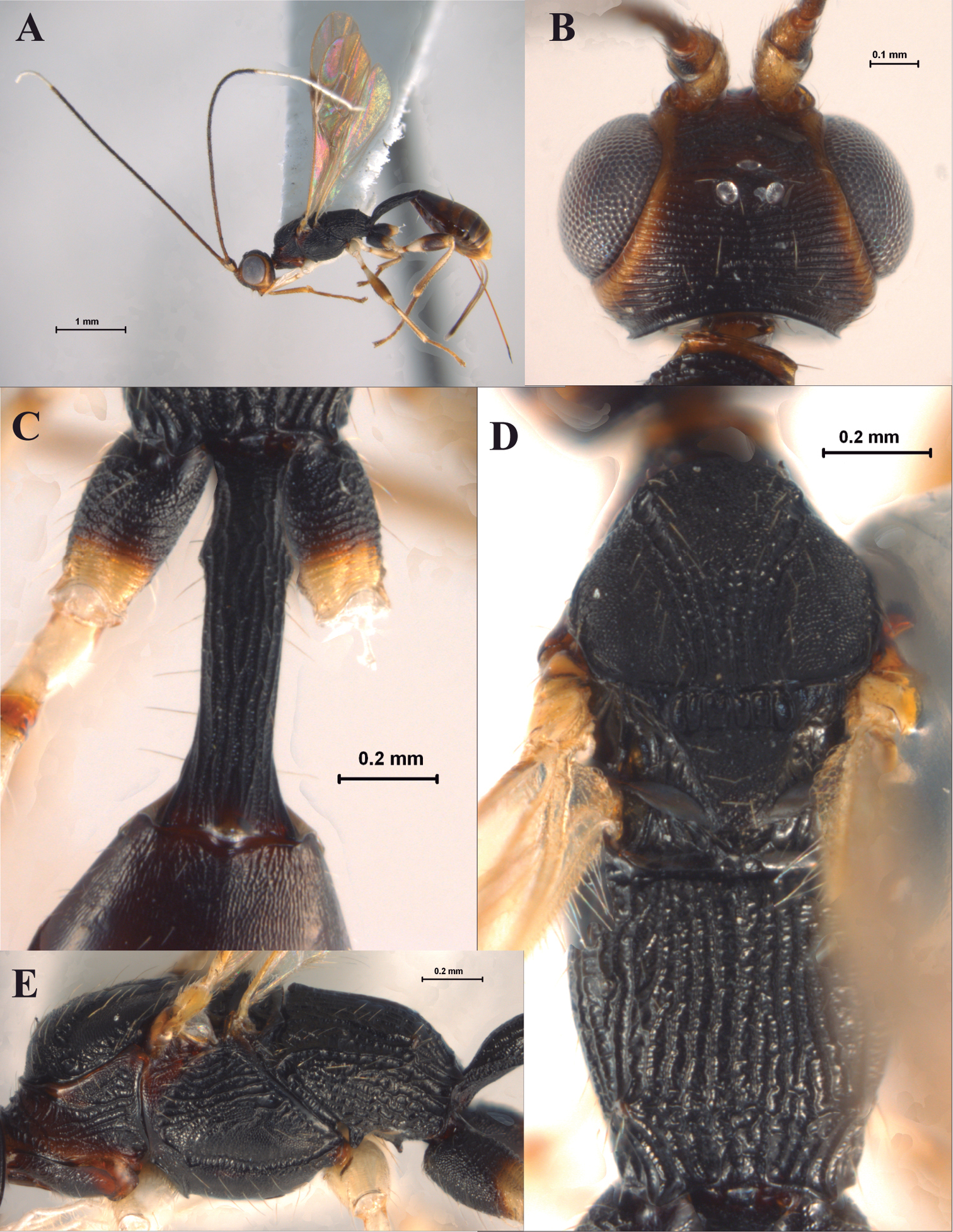






(C) 2012 E. Karen López-Estrada. This is an open access article distributed under the terms of the Creative Commons Attribution License 3.0 (CC-BY), which permits unrestricted use, distribution, and reproduction in any medium, provided the original author and source are credited.
For reference, use of the paginated PDF or printed version of this article is recommended.
We describe seven new species of the doryctine wasp genus Notiospathius Matthews & Marsh from Northwest Venezuela: Notiospathius araguae sp. n., Notiospathius bolivarisp. n., Notiospathius curvilineatus sp. n., Notiospathius dantei sp. n., Notiospathius estradae sp. n., Notiospathius larensis sp. n., and Notiospathius venezuelae sp. n. These represent the first described species of the genus reported for this country. Species boundaries for the above taxa were confirmed using the General mixed Yule-coalescent method with 441 DNA barcode sequences from specimens assigned to Notiospathius and other closely related genera collected in different countries along the Neotropics.
AbstractSe describen siete especies nuevas del género Notiospathius Matthews & Marsh para el noroeste de Venezuela: Notiospathius araguae sp. n., Notiospathius bolivarisp. n., Notiospathius curvilineatus sp. n., Notiospathius dantei sp. n., Notiospathius estradae sp. n., Notiospathius larensis sp. n., y Notiospathius venezuelae sp. n. Estas representan las primeras especies descritas del género registradas para Venezuela. La validez de estas especies fue confirmada empleando el método ‘General mixed Yule-coalescent’ con 441 secuencias del código de barras de especímenes asignados a Notiospathius y otros géneros cercanamente relacionadosprovenientes de varios países del Neotrópico.
Barcoding, GMYC model, integrative taxonomy, Neotropical region, parasitoid wasp.
Palabras claveBarcoding, modelo GMYC, taxonomía integral, Neotrópico, avispa parasitoide.
The wasp family Braconidae is a group mainly composed of parasitoids that attack a wide range of insect larvae from different orders, but mostly Coleoptera, Diptera and Lepidoptera (
Recently, a number of specimens assigned to Notiospathius, Tarasco and Masonius were collected by three of the authors (AZR, HC, RB) in different localities along northwest Venezuela. In this work, we describe seven new species of Notiospathius from this region following an integrative taxonomic approach (
A total of 243 specimens originally assigned to the genera Notiospathius, Masonius and Tarasco were obtained from several localities along four northwest Venezuelan states (Lara, Yaracuy, Carabobo and Aragua). All specimens were collected with yellow pan traps or sweeping nets and preserved in 100% ethanol until they were prepared for DNA extraction. Specimens are deposited in the following collections: Colección Nacional de Insectos, Instituto de Biología, Universidad Nacional Autónoma de México (IB-UNAM CNIN), Museo Entomológico “José M. Osorio”, Decanato de Agronomía, Universidad Centroccidental “Lisandro Alvarado”, Cabudare, Lara, Venezuela (UCOB), and Departamento de Ecologia e Biologia Evolutiva, Universidade Federal de São Carlos, São Carlos, SP, Brazil (DCBU). The wing venation and sculpture terminologies employed followed
We assessed species boundaries among the above Venezuelan specimens by obtaining DNA sequences from the standard animal DNA barcoding locus [cytochrome c oxidase I mitochondrial DNA gene (COI)]. DNA extraction, amplification and sequencing for these specimens was carried out at the University of Guelph, Ontario, Canada (see laboratory procedures in
Moreover, we obtained 12 additional sequences of specimens collected in various Neotropical countries (GenBank accession numbers JX870412-JX870423). These sequences were generated at the Instituto de Biología UNAM following the lab procedures described in
Species boundaries based on the 441 gathered COI sequences were assessed using the general mixed Yule-coalescent (GMYC) model (
List of the species delimited in this study, the Venezuelan states* where they were collected, number of representative specimens and GenBank accession numbers.
* = Costa Rica.
The GMYC analysis based on the ultrametric tree reconstructed with the lognormal coalescent prior is shown in the Supplementary material. The analysis yielded 112 “GMYC” species (confidence interval 100–112; -lnL of null model = 3392.3; -lnL of GMYC model = 3415.7; threshold time = -0.03), 52 of which were recovered as sequence clusters and 60 as singletons. The 267 Venezuelan specimens examined were segregated into 29 GMYC species, of which only one contained specimens from a different country (Costa Rica; Notiospathius venezuelae sp. n.). Two of these species actually belong to an undescribed genus that is morphologically similar but is distantly related to Notiospathius according to a recent multilocus phylogenetic study (Ceccarelli and Zaldívar-Riverón, submitted). Moreover, two separate clades contained most of the examined Venezuelan specimens (232 sequences), one comprising nine (spp. 2-10 in Supplementary Material) and the other one two (spp. 11 and 12) GMYC species, respectively. Species within each of these two clades were morphologically indistinguishable according to our examined features and therefore they will not be described until more evidence is gathered. Other three Venezuelan GMYC species assigned to Notiospathius were only represented by males or single, damaged, females, whereas five belong to Tarasco and one to Masonius. Below we describe the remaining seven GMYC species represented by Venezuelan specimens that also were delimited morphologically. A list with the species delimited in this study, the Venezuelan states where they were collected, number of representative specimens and their GenBank accession numbers is provided in Table 1.
Descriptionsurn:lsid:zoobank.org:act:BA858D04-A756-4F01-8100-63A34BBFF1A9
http://species-id.net/wiki/Notiospathius_araguae
Figs 1A–EThis species runs to Notiospathius platycorsus Marsh in
Female. Colour: Head light brown; scape light brown to honey yellow; flagellomeres brown turning dark brown, the last 10 white; palpi pale yellow to white. Mesonotum brown; propodeum, metapleuron and first metasomal tergite black; second and third metasomal tergites brown; remaining metasomal tergites dark brown except two last metasomal tergite, which are honey yellow; ovipositor and sheaths brown. Fore and middle coxae, trochanter and trochantellus pale yellow; femora and tibiae light brown; tarsi dark brown; hind coxa black; trochanter and trochantellus pale yellow; femur, tibia and tarsi ligth brown to brown. Wings dusky; veins and stigma brown; tegula pale yellow. Body length: 3.2 mm (lateral view); ovipositor 1.5 mm. Head: Clypeus rugose; face, frons and vertex striate, temple and gena smooth; eye about 1.6 times higher than wide (lateral view); malar space 0.1 times eye height (lateral view); temple 0.4 times eye width (dorsal view); hypoclypeal depression elliptic; ocular-ocellar distance four times diameter of lateral ocellus; length of scape twice its width (frontal view); antenna with 26 flagellomeres. Mesosoma: Length of mesosoma two times its maximum height; pronotum rugose, lateral area of pronotum coriaceous; pronotal groove wide and scrobiculate; propleuron slightly striate; mesoscutal lobes coriaceous; notauli wide and scrobiculate, meeting in scutellum in a costate area; scutellar disc coriaceous; mesopleural and subalar sulcus continuous, both wide, deep and scrobiculate; mesopleuron porcate dorsally, coriaceous medially and ventrally; precoxal sulcus wide, deep and scrobiculated, as long as mesopleuron; venter of mesosoma slightly coriaceous; metapleuron and propodeum strongly rugose; apical lateral corners without distinct tubercles; spines over hind coxa indistinct. Wings: Fore wing length 4.4 times its maximum width; length of pterostigma 3.3 times its maximum width; vein r 0.4 length of vein 3RSa; vein m-cu antefurcal to vein 2RS; vein 1cu-a interstitial to vein 1M; hind wing vein M+CU about 0.3 times length of vein 1M. Legs: hind coxa rugose, without basoventral tubercle; middle and hind femora smooth. Metasoma: First metasomal tergite rugose, length five times its apical width (dorsal view); basal sternal plate (acrosternite) about 0.7 times length of tergum; second metasomal tergite mostly smooth, only indistinctly costate near basal suture; suture between second and third metasomal tergites indistinct; third metasomal tergite and remaining metasomal tergites smooth and polished; ovipositor about 0.9 times length of metasoma.
Male. Smaller than female; body length 3 mm; head brown, orbit surrounding eyes yellow; antenna with 23 flagellomeres; second and third metasomal tergites light brown.
Female (IB-UNAM CNIN). Venezuela, Aragua, Henri Pittier National Park, 10.37428, -67.59279, 1070m, montane cloud forest/riparian, H. Clebsch, 7–11.x.08. DNA voucher no. (BOLD system) DORYC207-11, GenBank accession no. JN266962.
One specimen, male (DCBU). Same data as holotype, DNA voucher no. (BOLD system) DORYC210-11; GenBank accession no. JN266965.
Unknown.
The name of this species refers to the Venezuelan state where both type specimens were collected.
Notiospathius araguae sp. n.Female. Holotype: A habitus, lateral view B head, dorsal view C mesosoma, lateral view D mesosoma, dorsal view E first and second metasomal tergites, dorsal view.
urn:lsid:zoobank.org:act:6276E940-C7D2-4177-AEBF-1A9160A570A6
http://species-id.net/wiki/Notiospathius_bolivari
Figs 2A–EThis new species is morphologically similar to Notiospathius janzeni Marsh; however, it differs from the latter species by having a basoventral tubercle in the hind coxa (absent in Notiospathius janzeni) and mesopleuron porcate-coriaceous dorsally, coriaceous ventrally (porcate-rugose dorsally, weakly coriaceous to smooth ventrally in Notiospathius janzeni). Notiospathius bolivari is genetically similar to two species described below, Notiospathius larensis sp. n. and Notiospathius danteisp. n., though it differs from them by having the third metasomal tergite finely striate; and fourth and fifth metasomal tergites finely granulose (third, fourth and remaining metasomal tergites smooth and polished in Notiospathius dantei sp. n.and Notiospathius larensis sp. n.).
Female. Colour: Head brown; orbit surrounding eye honey yellow; pedicel and scape honey yellow; flagellomeres brown, apical 9 white (one antenna broken); palpi white. Mesonotum brown, venter of mesopleuron and propodeum black; first metasomal tergite black turning brown apically; second metasomal tergite dark brown with two sublateral light brown stripes; third metasomal tergite dark brown; fourth and fifth metasomal tergites dark brown with a semicircular basal area light brown; remaining metasomal tergites dark brown; ovipositor brown, apex strongly sclerotised; sheaths brown, turning dark brown to apex. Fore and middle coxae, trochanter and trochantellus white; femora brown on basal edge, remaining area white with a longitudinal dark brown stripe; tibiae dark brown dorsally, white ventrally; tarsi light brown; hind coxa brown dorsally, dark brown to black ventrally, apical edge white; trochanter and trochantellus white, femur brown on basal edge, basal third white, apical two thirds dark brown with a white irregular area medially; tibia dark brown dorsally, white ventrally; tarsi dark brown. Wings dusky; veins dark brown; stigma dark brown to black, white laterally; tegula honey yellow. Body length: 4.2 mm (lateral view), ovipositor 3 mm. Head: Clypeus rugose; face, frons and vertex striate-rugose; temple slightly striate; gena smooth; eye 0.8 times higher than wide (lateral view); malar space 0.5 times eye height (lateral view); temple 0.25 times eye width (dorsal view); ocular-ocellar distance 4 times diameter of lateral ocellus; length of scape 2 times its width (frontal view); antenna with 29 flagellomeres (one antenna broken). Mesosoma: Length of mesosoma 1.8 times its maximum height; pronotum slightly striate-rugose; pronotal groove wide and scrobiculate; propleuron slightly striate; median mesoscutal lobe striate rugose; lateral mesoscutal lobes striate-rugose, coriaceous medially; notauli wide, deep and scrobiculate, not joining and obscured at middle of mesoscutum in a longitudinally striate-rugose area; scutellar disc coriaceous; subalar and mesopleural sulcus continuous, joining at middle of mesopleuron, the first one wide, deep and scrobiculate, the second one narrow, deep and slightly scrobiculate; mesopleuron porcate-coriaceous dorsally, coriaceous ventrally; precoxal sulcus wide, anterior half shallow and slightly scrobiculated, posterior half deep and scrobiculate, 0.85 as long as mesopleuron; venter of mesosoma coriaceous; metapleuron rugose- areolate, slightly coriaceous anteriorly; propodeum rugose-areolate; apical lateral corners without tubercles; spines over hind coxa absent. Wings: Fore wing length 3.3 times its maximum width; length of pterostigma 3.2 times its maximum width; vein r 0.3 length of vein 3RSa; vein m-cu distinctly antefurcal to vein 2RS; vein 1cu-a postfurcal to vein 1M; hind wing vein M+CU 0.7 times length of vein 1M. Legs: hind coxa striate dorsally, coriaceous ventrally, with a distinct basoventral tubercle; middle and hind femora coriaceous. Metasoma: First metasomal tergite costate with carinate microsculpture, with lateral spine-like projections at basal third of tergite; length 1.6 times its apical width (dorsal view); basal sternal plate (acrosternite) about 0.6 times length of tergum; second metasomal tergite striate with carinate microsculpture; suture between second and third metasomal tergites distinct and sinuate; third metasomal tergite finely striate; fourth and fifth metasomal tergites finely granulose, remaining metasomal tergites smooth and polished; ovipositor about 1.3 times length of metasoma.
Male. Unknown.
Northwest Venezuela, state of Aragua.
Female (IB-UNAM CNIN). Venezuela, Aragua, Henri Pittier National Park, 10.37428, -67.59279, 11-12.ix.07 YPT/78 plates, 1070m Montane cloud forest/riparian, H. Clebsch, DNA voucher no. (BOLD system) DORYC212-11, GenBank accession no. JN266967.
Unknown.
This species is named in honour to Simón Bolívar, the South American military and political leader who led Venezuela, Colombia, Ecuador, Peru and Bolivia to independence.
Notiospathius bolivari sp. n. Female. Holotype: A habitus, lateral view B fore wing C mesosoma, lateral view D metasoma, dorsal view E metasoma, dorsal view.
urn:lsid:zoobank.org:act:8975DEB8-F0E4-45D0-9A5C-76A12187C839
http://species-id.net/wiki/Notiospathius_curvilineatus
Figs 3A–DNotiospathius curvilineatus sp. n. is distinguished from the remaining described species of the genus by having a combination of the mesopleuron diagonally costate from postero-median to medio-ventral region medially and ventrally, and the first three metasomal tergites sculptured. This species runs to Notiospathius janzeni in
Female. Colour: Head brown to reddish brown; scape pale yellow with a brown longitudinal stripe laterally; flagellomeres dark brown turning black to apex, apical 9 white; palpi white. Mesosoma and first metasomal tergite reddish brown to brown; second metasomal tergite dark brown, yellow basolaterally; third metasomal tergite yellow, dark brown apically;remaining metasomal tergites brown except the last one which is yellow; ovipositor and sheaths brown to reddish brown. Fore and middle coxae, trochanter and trochantellus pale yellow; femora pale yellow with a median and an apical dark brown transverse bands dorsally; tibiae pale yellow basally, light brown medially and apically, with a dark brown transverse band dorso-basally; tarsi light brown to brown; hind coxa pale yellow, brown apically; trochanter and trochantellus honey yellow; femur pale yellow on basal third, apical two thirds dark brown; tibia pale yellow basally, light brown medially and apically, with a dark brown transverse band dorso-basally; tarsi brown. Wings dusky; veins and stigma dark brown; tegula yellow. Body length: 5.8 mm (lateral view); ovipositor 6.8 mm. Head: Clypeus rugose; face straite; frons striate; vertex striate; temple and gena smooth; eye 1.5 times higher than wide (lateral view); malar space 0.4 times eye height (lateral view); temple 0.2 times eye width (dorsal view); hypoclypeal depression elliptic; ocular-ocellar distance 2.6 times diameter of lateral ocellus; length of scape 1.4 times its width (frontal view); antenna with 35 flagellomeres. Mesosoma: Length of mesosoma 1.9 times its maximum height; pronotum longitudinally costate-coriaceous; pronotal groove wide and slightly scrobiculate; propleuron slightly striate; lateral mesoscutal lobes coriaceous medially, transversally costate along notauli and edges; median mesocutal lobe transversally costate-rugose; notauli wide, deep and scrobiculate, meeting just before scutellum in a longitudinally costate-rugose area; scutellar disc smooth; mesopleural and subalar sulcus discontinuous, the first one deep and scrobiculate and the second one wide, deep and including the striate sculpture of mesopleuron; mesopleuron porcate-slightly coriaceous dorsally, slightly curved, diagonally costate from postero-median to medio-ventral region medially and ventrally; precoxal sulcus wide, deep and including the striate sculpture of mesopleuron, as long as mesopleuron; venter of mesosoma smooth and polished; metapleuron costate ventrally, rugose-aerolate dorsally, slightly coriaceous on anterior first third; propodeum rugose; apical lateral corners without distinct tubercles; spines over hind coxa indistinct. Wings: Fore wing length 4.3 times its maximum width; length of pterostigma 2.8 times its maximum width; vein r 0.2 length of vein 3RSa; vein m-cu antefurcal to vein 2RS; vein 1cu-a distinctly postfurcal to vein 1M; hind wing vein M+CU about 0.4 times length of vein 1M. Legs: hind coxa striate, indistinct tubercule at the base; middle and hind femora slightly coriaceous. Metasoma: First metasomal tergite strongly costate with rugose microsculpture, length 3.1 times its apical width (dorsal view); basal sternal plate (acrosternite) about 0.6 times length of tergum; second metasomal tergite costate with rugose microsculpture; suture between second and third metasomal tergites distinct and sinuate; third metasomal tergite coriaceous on basal half, smooth on apical half; remaining metasomal tergites smooth and polished; ovipositor about 1.8 times length of metasoma.
Male. Unknown.
Females: Body length: close to 5.8 mm; ovipositor about 5.8–6.8. Head: Eye 1.4–1.5 times higher than wide (lateral view); scutellar disc slightly coriaceous to smooth. Wings: Fore wing length 4.1–4.3 times its maximum width; length of pterostigma 2.8–3.7 times its maximum width. Metasoma: length of first metasomal tergite 3.1–3.7 times its apical width (dorsal view); ovipositor about 1.6–1.8 times length of metasoma.
Female (UCOB). Venezuela, Lara, Parque Nacional Cerro Saroche, sector Cañaote #3, 10°11.83'N, 69°26.13'W, 929 m, 15–19.vii.08, DNA voucher no. (BOLD system) DORYC235-11, GenBank accession no. JN266985.
One female (DCBU). Venezuela, Lara, Parque Nacional Cerro Saroche, La Cimara # 3, 7–10.x.2008, 10°12.656N, 69°25.339W, YPT, R. Briceño col., DNA voucher no. (BOLD system) DORYC234-11, GenBank accession no. JN266984.
Unknown.
urn:lsid:zoobank.org:act:26384071-6B8F-4AC7-89FC-411C6046796A
http://species-id.net/wiki/Notiospathius_dantei
Figs 4A–DThis new species is morphologically and genetically similar to one of the species described below, Notiospathius larensis sp. n., though it differs from the latter species by having the mesonotum reddish brown (brown to dark brown in Notiospathius larensis sp. n.); first metasomal tergite reddish brown at extreme base, black medially, turning reddish brown to apex (completely black in Notiospathius larensis sp. n.); and mesopleural and subalar sulcus continuous, joining at middle of mesopleuron (not joining in Notiospathius larensis sp. n.). Notiospathius dantei differs from the remaining described species of the genus with basoventral tubercle on hind coxa by having the following combination of features: first two metasomal tergites sculptured, remaining ones smooth; apical 10 flagellomeres lighter than remaining ones; mesopleuron porcate-sligthly coriacoeus dorsally and medially, coriaceous ventrally; lateral mesoscutal lobes coriaceous medially, striate-rugose laterally; median mesoscutal lobes coriaceous anteromedially.
Female. Colour: Head dark brown; area near mandible and orbit surrounding eye honey-yellow; pedicel honey yellow, brown dorsally; flagellomeres brown, turning light brown to apex, apical 10 white (one antenna broken); palpi white. Mesonotum reddish brown to dark brown, first metasomal tergite reddish brown at extreme base, black medially and turning reddish brown to apex; second metasomal tergite dark brown with a semicircular basal area light brown; third and fourth metasomal tergites light brown basally and medially, dark brown apically; remaining metasomal tergites dark brown; ovipositor and sheaths reddish brown, ovipositor apex strongly sclerotized, black. Fore and middle coxae, trochanter and trochantellus white, femora brown at the base, following by white and turning brown to light brown to apex, tibiae and tarsi light brown; hind coxa light brown to brown, trochanter and trochantellus white, femur white at basal third, apical two thirds brown, tibia and tarsi brown. Wings dusky; veins dark brown; stigma pale yellow at extreme base, remaining area dark brown; tegula honey-yellow. Body length: 4.1 mm (lateral view), ovipositor 3.7 mm. Head: Clypeus striate-rugose; face straite; frons striate-rugose; vertex striate-slightly rugose; temple slightly striate; gena smooth; eye 1.4 times higher than wide (lateral view); malar space 0.4 times eye height (lateral view); temple 0.5 times eye width (dorsal view); hypoclypeal depression elliptic; ocular-ocellar distance 6 times diameter of lateral ocellus; length of scape less than 1.2 times its width (frontal view); antenna with 29 flagellomeres (one antenna broken). Mesosoma: Length of mesosoma 1.9 times its maximum height; pronotum striate; pronotal groove wide and scrobiculate; propleuron laterally striate, remaining area slightly coriaceous; lateral mesoscutal lobes coriaceous medially, striate-rugose laterally; median mesoscutal lobes coriaceous anteromedially, remaining area transversally striate-rugose; notauli wide, deep and scrobiculate, not joining, obscuring at middle of mesoscutum in a longitudinally striate-rugose area; scutellar disc slightly coriaceous; mesopleural and subalar sulcus continuous, joining at middle of mesopleuron, the first one deep, narrow and scrobiculate, the second one wide, deep and including the porcate sculpture of mesopleuron; mesopleuron porcate-sligthly coriacoeus dorsally and medially, coriaceous ventrally; precoxal sulcus wide, deep and scrobiculate, as long as mesopleuron; venter of mesosoma slightly coriaceous; metapleuron longitudinally costate with rugose microsculpture; propodeum longitudinally costate-rugose; apical lateral corners with tubercles; spines over hind coxa absent. Wings: Fore wing length 4.1 times its maximum width; length of pterostigma 3.2 times its maximum width; vein r 0.3 length of vein 3RSa; vein m-cu distinctly antefurcal to vein 2RS; vein 1cu-a slightly postfurcal to vein 1M; hind wing vein M+CU 0.4 times length of vein 1M. Legs: hind coxa striate, with an almost indistinct basoventral tubercle; middle and hind femora slightly coriaceous. Metasoma: First metasomal tergite costate with rugose microsculpture; length 2.3 times its apical width (dorsal view); basal sternal plate (acrosternite) about 0.7 times length of tergum; second tergite striate with rugose microsculpture; suture between second and third metasomal tergites distinct and slightly sinuate; remaining metasomal tergites smooth and polished; ovipositor about 1.7 times length of metasoma.
Male. Unknown.
Northwest Venezuela, state of Yaracuy.
Female (IB-UNAM CNIN). Venezuela, Yaracuy, Est. Biol. Guáquira, 10°17.84'N, 68°39.32'W, 107 m, sweep, selva trop., DNA voucher no. (BOLD system) DORYC278-11, GenBank accession no. JN267024.
Unknown.
urn:lsid:zoobank.org:act:52FF943B-8C41-4823-8DB3-F18BC9602BCC
http://species-id.net/wiki/Notiospathius_estradae
Figs 5A–DThis species is similar to Notiospathius shawi Marsh, though it can be distinguished from the latter species by having the mesopleuron coriaceous-slightly rugose dorsally, coriaceous medially and ventrally (costate dorsally and coriaceous ventrally in Notiospathius shawi), and notauli obscuring before scutellum in a large porcate-rugose area (meeting before scutellum in a narrow rugose area in Notiospathius shawi).
Female. Colour: Head light brown to honey yellow; scape honey yellow; flagellomeres honey yellow turning dark brown to apex; palpi pale yellow. Mesosoma and first metasomal tergite black, pronotum light brown on half basal half, black on apical half; second metasomal tergite dark brown; third metasomal tergite and remaining metasomal tergites brown to dark brown; last one pale yellow; ovipositor brown; sheaths honey yellow. Fore and middle coxae light brown to honey yellow; trochanter and trochantellus pale yellow; femora brown; tibiae pale yellow basally, honey yellow medially and apically; tarsi honey yellow; hind coxa black; trochanter and trochantellus pale yellow; femur dark brown; tibia pale yellow basally turning light to apex; tarsi light brown. Wings dusky, veins and stigma dark brown, tegula dark brown to black. Body length: 4.4 mm (lateral view); ovipositor 3.8 mm. Head: Clypeus rugose; face, frons and vertex striate; temple and gena smooth; eye about 0.9 times higher than wide (lateral view); malar space 0.6 times eye height (lateral view); temple 0.2 times eye width (dorsal view); hypoclypeal depression elliptic; ocular-ocellar distance 1.5 times diameter of lateral ocellus; length of scape twice its width (frontal view); antenna with 29 flagellomeres. Mesosoma: Length of mesosoma 1.9 times its maximum height; pronotum coriaceous; pronotal groove narrow and slightly scrobiculate; propleuron slightly striate; mesoscutal lobes coriaceous; notauli wide and scrobiculate, not joining, obscuring in a large porcate-rugose area; scutellar disc coriaceous; mesopleural and subalar sulcus continuous, both deep and scrobiculate; mesopleuron coriaceous-slightly rugose dorsally, coriaceous medially and ventrally; precoxal sulcus wide, deep and scrobiculate, as long as mesopleuron; venter of mesosoma coriaceous; metapleuron and propodeum strongly rugose with coriaceous microsculpture; apical lateral corners without distinct tubercles; spines over hind coxa indistinct. Wings: Fore wing length 4.3 times its maximum width; length of pterostigma 3.6 times its maximum width; vein r 0.3 length of vein 3RSa; vein m-cu intersticial to vein 2RS; vein 1cu-a distinctly postfurcal to vein 1M; hind wing vein M+CU about 0.5 times length of vein 1M. Legs: hind coxa coriaceous, with a distinct basoventral tubercle; middle and hind femora smooth. Metasoma: First metasomal tergite strongly costate with rugose microsculpture, length twice its apical width (dorsal view); basal sternal plate (acrosternite) about 0.5 times length of tergum; second metasomal tergite costate with rugose microsculpture; suture between second and third metasomal tergites distinct and sinuate; third metasomal tergite costate on basal half, smooth on apical half; remaining metasomal tergites smooth and polished; ovipositor about 1.8 times length of metasoma.
Male. Unknown.
Females: Colour: head dark brown; orbit surrounding eyes yellow. Body length: 4.4–5.4 mm (lateral view); ovipositor 3.6–4.2 mm. Head: Eye 0.9–1.3 times higher than wide (lateral view). Wings: Fore wing length 4.2–4.6 times its maximum width; length of pterostigma 2.8–3.6 times its maximum width. Metasoma: length of first metasomal tergite 1.3–2.0 times its apical width (dorsal view); ovipositor 1.5–1.8 times length of metasoma.
Female (UCOB). Venezuela, Lara, Parque Nacional Cerro Saroche, sector Batatal # 4, 10°09.15'N, 69°30.205'W, 809 m, 7–11.x.08, DNA voucher no. (BOLD system) DORYC286-11; GenBank accession no. JN267031.
Three females (IB-UNAM CNIN). Same data as holotype, DNA voucher nos (BOLD system) DORYC285-11, DORYC 287-11, IB-CNIN569, GenBank accession nos JN267030, JN267032, JN870425.
Unknown.
urn:lsid:zoobank.org:act:90728947-9EBB-432D-B51C-8AAF57F3C73A
http://species-id.net/wiki/Notiospathius_larensis
Figs 6A–DThis species is morphologically similar to Notiospathius dantei, but they differ by the morphological features mentioned in the diagnosis of the latter species. Notiospathius larensisdiffers from the remaining species of the genus with basoventral tubercle on the hind coxa by having the following combination of features: vertex rugose-striate; mesoscutal lobes coriaceous medially, striate-rugose laterally or anteromedially; mesopleuron porcate dorsally, rugose-coriaceous to coriaceous medially and ventrally; first two metasomal tergites scultpured, remaining ones smooth.
Female. Colour: Head brown; orbit surrounding eyes yellow; scape and pedicel light brown; flagellomeres brown, apical 10 white (broken); palpi white. Mesonotum brown to dark brown; propodeum, metapleuron and first metasomal tergite black, brown apically; second metasomal tergite dark brown with a light brown basal semicircular area; third and fourth metasomal tergites brown; remaining metasomal tergites brown to light brown, ovipositor and sheaths brown to honey yellow, ovipositor apex strongly sclerotized, black. Fore and middle coxae white; trochanter and trochantellus pale yellow; fore femur light brown; middle femur brown; fore and middle tibia and tarsi light brown; hind coxa dark brown; trochanter and trochantellus honey yellow; femur honey yellow at basal first third, apical two thirds dark brown; tibia brown; tarsi dark brown. Wings dusky, veins and tegula honey yellow; stigma yellow at basal third, dark brown apically. Body length: 4.2 mm (lateral view), ovipositor 3.3 mm. Head: Clypeus straite-rugose; face striate; frons rugose; vertex rugose-striate; temple weakly striate dorsally, gena smooth; eye 1.1 times higher than wide (lateral view); malar space almost 0.4 times eye height (lateral view); temple 0.2 times eye width (dorsal view); hypoclypeal depression elliptic; ocular-ocellar distance 3 times diameter of lateral ocellus; length of scape less than 1.5 times its width (frontal view); antenna with 30 flagellomeres (broken). Mesosoma: Length of mesosoma 1.9 times its maximum height; pronotum striate dorsally, slightly rugose ventrally; pronotal groove, wide and scrobiculate; propleuron striate; lateral mesoscutal lobes coriaceous medially, striate-rugose laterally; median mesoscutal lobe coriaceous anteromedially, remaining area striate-rugose; notauli scrobiculate, not joining, obscuring in a longitudinally striate-rugose area; scutellar disc coriaceous; mesopleural and subalar sulcus discontinuous, both deep and narrow; mesopleuron porcate dorsally, including subalar area, rugose-coriaceous antero-ventrally, coriaceous ventrally; precoxal sulcus wide, deep and scrobiculate, as long as mesopleuron; venter of mesosoma slightly coriaceous; metapleuron striate; propodeum longitudinally striate; apical lateral corners with distinct tubercles; spines over hind coxa indistinct. Wings: Fore wing length 5.1 times its maximum width; length of pterostigma three times its maximum width; vein r 0.5 length of vein 3RSa; vein m-cu antefurcal to vein 2RS; vein 1cu-a distinctly postfurcal to vein 1M; hind wing vein M+CU 0.4 times length of vein 1M. Legs: fore tibia with a row of at least seven spines; hind coxa striate, with a distinct basoventral tubercle; middle and hind femora slightly striate. Metasoma: First metasomal tergite strongly rugose anteriorly, costate with rugose microsculpture medially and posteriorly, length three times its apical width (dorsal view); basal sternal plate (acrosternite) about 0.7 times length of tergum; second metasomal tergite striate; suture between second and third metasomal tergites distinct and straight; remaining metasomal tergites smooth and polished; ovipositor about 1.6 times length of metasoma.
Male.Unknown
Females: Head: scape and pedicel with a brown stripe laterally Body length: close to 4.0–4.2 mm; ovipositor about 3.3–3.8. Head: Eye 1.1–1.4 times higher than wide (lateral view). Wings: Fore wing length 3.8–4.1 times its maximum width; length of pterostigma 3.0–3.5 times its maximum width. Metasoma: length of first metasomal tergite 2.6–3.0 times its apical width (dorsal view).
Female (UCOB). Venezuela, Lara, Parque Nacional Cerro Saroche, sector Batatal, 10°09.15'N, 69° 30.205'W, 809 m, 15–19.vii.2008, YTP, R. Briceño col., DNA voucher no. IB-CNIN567; GenBank accession no. JN870424.
Two females (IB-UNAM CNIN, DCBU).One female, Venezuela, Lara, Parque Nacional Cerro Saroche, La Cimara #5, 10°12.656'N, 69°25.339'W, 7-10.x.2009, R. Briceño col., DNA voucher no. (BOLD systems) DORYC241-11; GenBank accession no. JN266991; one female, Venezuela, Lara, Parque Nacional Cerro Saroche, Cañaote #3, 10°11.83'N, 69°26.13'W, 929 m, 15–19.vii.08, col. R. Briceño, DNA voucher no. (BOLD systems) DORYC237-11; GenBank accession no. JN266987.
Unknown.
urn:lsid:zoobank.org:act:4C4BD7CE-586B-4142-BA7A-CC22284E094B
http://species-id.net/wiki/Notiospathius_venezuelae
Figs 7A–EThis species runs to Notiospathius leucacrocera (Enderlein) in the extension (
Female. Colour: Head dark brown to black; orbit surrounding eyes yellow; scape light brown, with a brown stripe; flagellomeres dark brown, last 11 white; palpi white. Mesosoma and first metasomal tergite black except pronotum wich is brown; second metasomal tergite dark brown; third, fourth and fifth metasomal tergites brown with a light brown band at the middle; sixth metasomal tergite dark brown, pale yellow in apex; remaining metasomal tergites pale yellow; ovipositor brown; sheaths pale yellow turning dark brown. Fore and middle coxae and trochanter white, trochantellus brown, femora pale yellow on basal third, brown on apical two thirds, pale yellow apically, tibiae light brown, tarsi brown; hind coxa black, pale yellow apically; trochanter pale yellow; trochantellus brown; femur white to pale yellow on basal third, brown on apical two thirds, pale yellow at extreme apex; tibia pale yellow basally, turning light brown apically; tarsi brown. Wings dusky; veins and stigma brown; tegula light brown. Body length: 4.1 mm (lateral view), ovipositor 1.6 mm. Head: Clypeus rugose; face, frons and vertex striate; temple slightly striate; gena smooth; eye about 1.1 times higher than wide (lateral view); malar space 0.2 times eye height (lateral view); temple 0.2 times eye width (dorsal view); hypoclypeal depression elliptic; ocular-ocellar distance three times diameter of lateral ocellus; length of scape twice its width (frontal view); antenna with 28 flagellomeres. Mesosoma: Length of mesosoma 2.1 times its maximum height; pronotum coriaceous; pronotal groove wide and coriaceous; propleuron striate; mesoscutal lobes coriaceous; notauli narrow, scrobiculate and with coriaceous microsculpture, not joining, obscuring in a large costate area; scutellar disc coriaceous; mesopleural and subalar sulcus continuous, both scrobiculate; mesopleuron porcate-coriaceous dorsally, coriaceous medially and ventrally; precoxal sulcus narrow, deep and scrobiculated, as long as mesopleuron; venter of mesosoma coriaceous; metapleuron and propodeum costate with rugose microsculpture; apical lateral corners with distinct tubercles; spines over hind coxa distinct. Wings: Fore wing length 5.1 times its maximum width; length of pterostigma 3.3 times its maximum width; vein r 0.3 length of vein 3RSa; vein m-cu antefurcal to vein 2RS; vein 1cu-a distinctly antefurcal to vein 1M; hind wing vein M+CU about 0.5 times length of vein 1M. Legs: hind coxa rugose at the base, striate posteriorly, indistinct tubercule at the base; middle and hind femora coriaceous. Metasoma: First metasomal tergite strongly costate with rugose microsculpture, length 3.2 its apical width (dorsal view); basal sternal plate (acrosternite) about 0.7 times length of tergum; second metasomal tergite slightly costate; suture between second and third metasomal tergites distinct and sinuate; third metasomal tergite smooth; remaining metasomal tergites smooth and polished; ovipositor about 0.7 times length of metasoma.
Male. Essentially as female; pronotum light brown; third and fourth metasomal tergites light brown with a honey yellow band at the middle; antenna with 24 flagellomeres dark brown, only last three white.
Females: Body length: 2.8–4.1 mm (lateral view), ovipositor 1.0–1.6 mm. Head: Eye 1.1–1.2 times higher than wide (lateral view); malar space 3.3–4.5 mm Wings: Fore wing length 4.2–5.1 times its maximum width, length of pterostigma 2.8–3.6 times its maximum width. Metasoma: length of first metasomal tergite 3.2–3.6 times its apical width (dorsal view).
Female (IB-UNAM CNIN). Venezuela, Carabobo, Palmichal, 10.28590, -68.23993, 93m, 30–3.viii.07, YTP/68 plates, shade coffee, orange grove, H. Clebsch, L. García col., DNA voucher no. (BOLD system) DORYC208-11; GenBank accession no. JN266963.
Four specimens, three males, one female (IB-UNAM CNIN, UCOB). One female and two male, same data as holotype, DNA voucher nos (BOLD system) DORYC206-11, DORYC213-11, GenBank accession nos JN266961, JN266968; one male, Venezuela Yaracuy Mpio. San Felipe, Est. Biol. Guáquira, 107 m, 10°17.84'N, 68°39.32'W, sweep, 11:00 am, selva tropical, DNA voucher no. IB-CNIN-396, GenBank accession no. JN870300; one male, Costa Rica, Heredia, 11 km ESE La Virgen, 10°21'N, 84°03'W, 20-II-2004, INBIO-OET transect, 250-350 m, DNA voucher no. IB-CNIN537, GenBank accession no. JN870400.
Unknown.
We have named this species after the country where most of the specimens of this new species were collected.
Notiospathius venezuelae sp. n.Female. Holotype: A habitus, lateral view B head, dorsal view C first and second metasomal tergites, dorsal view D mesosoma, dorsal view E mesosoma, lateral view.
We thank Ma. Cristina Mayorga-Martínez for her help in the Hymenoptera collection at CNIN-IB-UNAM; to Susana Guzman-Gómez (UNIBIO, IB-UNAM) for helping with microscope photography; and to Luciana B. R. Fernandes from Instituto Nacional de Ciência e Tecnologia dos Hymenoptera Parasitoides da Região Sudeste Brasileira (INCT/Hympar Sudeste) for taking some of the SEM pictures. This work was funded by grants given by the Consejo Nacional de Ciencia y Tecnología (CONACyT), México (Proyectos Ciencia Básica SEP-CONACyT 2008; red Temática del Código de Barras de la Vida), and the Ministerio de Ciencia e Innovación (CGL2010-15786; Spain) to AZR, a grant given by the Consejo de Desarrollo Científico, Humanístico y Tecnológico (Venezuela; CDCHT-UCLA- Proyecto 004-AG-2008), to RBG, a grant given by the Conselho Nacional de Desenvolvimento Científico e Tecnológico (CNPq), fundação de amparo à Pesquisa do Estado de São Paulo (FAPESP) to AMPD, a grant given by the Coordenação de Aperfeiçoamento de Pessoal de Nível Superior (Capes) to JFN and AMPD, and a postdoctoral fellowship given by DGPAPA-UNAM (Mexico) to FSC.
Laboratory analyses on sequences generated in Guelph since 2009 were funded by the Government of Canada through Genome Canada and the Ontario Genomics Institute (2008-0GI-ICI-03).
Species delimitation using the GMYC method. doi: 10.3897/JHR.29.3555.app
Explanation note: Ultrametric tree derived from the BEAST analysis showing the species boundaries recovered with the GMYC model and the SPLITS program for 441 DNA barcoding sequences belonging to specimens assigned to Notiospathius, Tarasco and Masonius that were collected in different localities along the Neotropics. Black terminal branches refer to species represented by a single specimen (singletons). Species represented by sequence clusters are coloured in red. Codes of terminal taxa: DORYC = BOLD process ID for Venezuelan specimens; Arg = Argentina; Bra = Brazil; Col = Colombia; Cri = Costa Rica; Cub = Cuba; Dom = Dominican Republic; Ecu = Ecuador; Fgu = French Guyana; Moa = Mexico, Oaxaca; Mve = Veracruz, Mexico; Tri = Trinidad and Tobago; Ven = Venezuela; Spat = Spathius.
Copyright notice: This dataset is made available under the Open Database License (http://opendatacommons.org/licenses/odbl/1.0/). The Open Database License (ODbL) is a license agreement intended to allow users to freely share, modify, and use this Dataset while maintaining this same freedom for others, provided that the original source and author(s) are credited.
